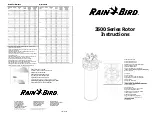
4
4
Symbols and Illustrations
Symbols and Illustrations
Symbols
Illustrations
LD
HB
HRB
HRC
HSD
HV
Leeb hardness value used with impact device D
Brinell hardness value
Rockwell B hardness value
Rockwell C hardness value
Shore hardness value
Vicker hardness value
Measurement and Conversion Table
Range for measurement and conversion:
IMPACT DEVICE D
HLD: 170-960
H R C
H R B
H B
H V
H S D
STEEL
20.0-67.9
59.6-99.5
80-647
80-940
32.5-99.5
CWT.ST
20.5-67.1
80-898
ST.STEEL
19.6-62.4
46.5-101.7
85-655
85-802
GC. IRON
93-334
NC.IRON
131-387
C.ALUM
30-159
BRASS
13.5-95.3
40-173
BRONZE
60-290
COPPER
45-315
5
Preparation Before Measuring
Requirements for the sample
The surface temperature of sample should be less than 120
C.
The samples must feature a metallic smooth, ground surface, in order to eliminate erroneous measurements
brought about by coarse grinding or lathe scoring. The roughness of the finished surface should not exceed
2μm.
Requirements for the weight of the sample
For samples weighing over 5 kg and of compact shape, no support is needed.
Samples weighing between 2-5 kg, and also for heavier samples with protruding parts or thin walls, should
be placed on a solid support in such a manner that they do not bend or move by the impact force.
Samples weighing less than 2 kg should be firmly coupled with a stable support weighing over 5 kg.
For coupling purposes,
The coupling surface between the sample and base plate should be flat, plane parallel and ground.
A thin proper layer of coupling paste is to be applied to the contact surface of the sample.
The sample should be firmly pressed against the surface of the base plate by moving it with a circular
motion.
The direction of impact should be perpendicular to the coupling surface.
For the coupling operation, the following prerequisites must be fulfilled:
The contact surface of the sample and the surface of the base plate must be flat, plane parallel and
ground.
The direction of the test impact must be perpendicular to the coupled surface.
Minimum thickness of the sample for coupling (5mm).
5.1
Proper Coupling
Proper coupling requires a little experience. Insufficiently coupled samples produce large variations of
individual measurements, L-values which are too low and the operation is characterized by a rattling noise
upon impact of the test tip.
Example for coupling a test piece with a base plate:





























